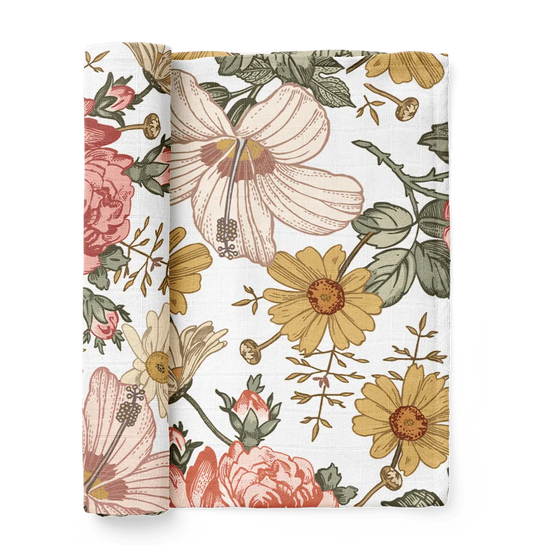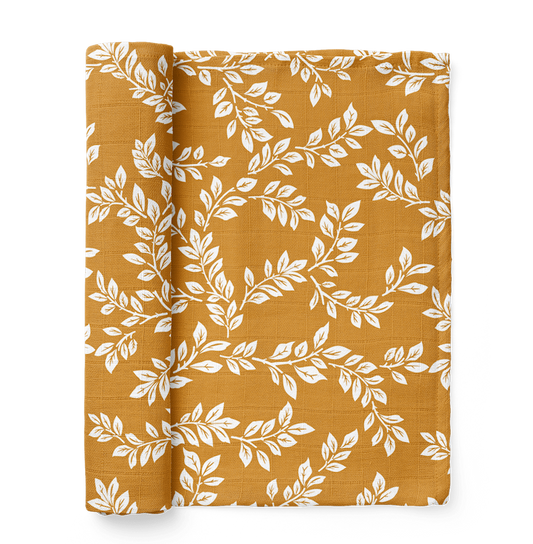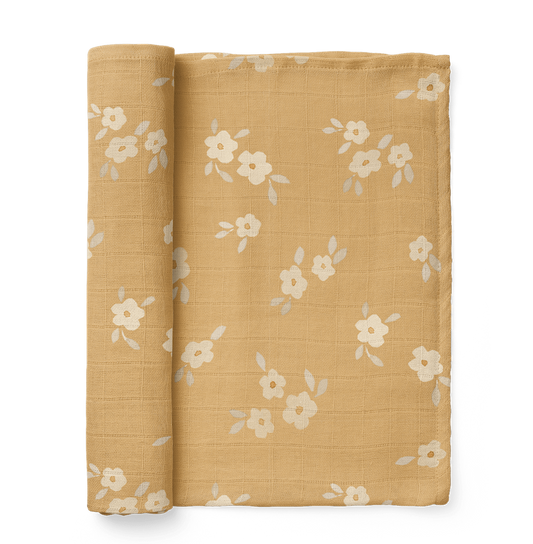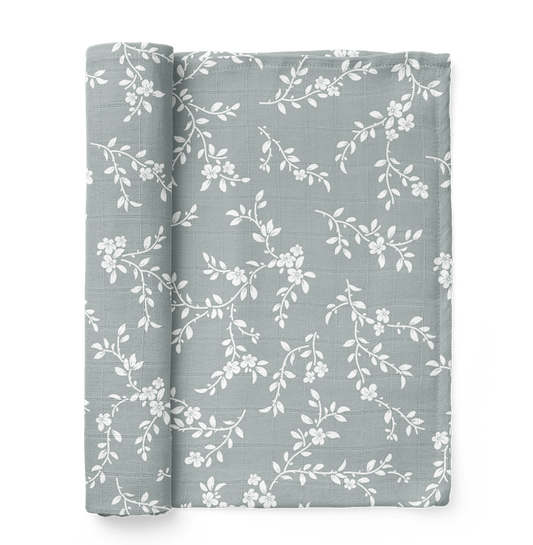Welcoming a new member to the family comes with a myriad of preparations, and one essential item is the baby blanket. These cozy companions provide warmth, comfort, and security for your little one. In this guide, we'll explore the different types of baby blankets and key considerations when choosing the perfect one.
Types of Baby Blankets:
Baby blankets come in various types, each serving a unique purpose to cater to the diverse needs of infants. Here's a breakdown of the different types of blankets:
Swaddle Blankets:
Swaddle blankets, commonly known as 'newborn wraps,' offer dimensions ranging from 40 x 40 inches to 48 x 48 inches, providing ample fabric for comfortable and secure wrapping. Available in an array of colors and patterns, these swaddle blankets add a delightful touch, making them equally cute for baby boys and baby girls. The versatility of designs ensures that you can swaddle your little one in a charming blanket that suits their unique style and personality."
Types of Swaddle Blankets:
Swaddle blankets come in various materials, with the most common being stretchy fabric or cotton gauze. Not just functional, these blankets also serve as versatile accessories for capturing early moments. Used by newborn photographers as photo props, swaddle blankets showcase the tiny and flexible nature of newborns, portraying the beauty of their early days.
Popular Choices:
The most common type is crafted from double gauze cotton, earning its reputation as the perfect blanket for newborns. Loved for its light-weight and breathable properties, it ensures a gentle wrap for the baby. Its moisture-wicking feature keeps the baby dry and cozy. The large size adds to its versatility, allowing for various swaddling techniques.
The "Perfect Baby Blanket" and Ideal Baby Shower Gift:
Swaddle blankets, with their soft and comforting embrace, are often considered the perfect blanket for newborns. Their ability to create a cozy and calming environment has led to them being dubbed "security blankets." These breathable blankets are also used as a nursing cover.
Given their versatility and popularity, they make for an ideal baby shower gift, playing a significant role in the early days of a baby's life.
Crib Blankets:
Crib blankets play a crucial role in adorning the nursery and ensuring a cozy sleep environment for your baby, with standard dimensions of around 28 x 52 inches.
Often, a crib blanket is part of a baby bedding set, featuring a quilt, a plush blanket, or a minky. These blankets are not only functional but also add an aesthetic touch to the nursery. Many parents display them as decorative items, often set out like a throw blanket or hung on the side of the crib or rocking chair.
While your baby is not likely to use these blankets as a warm cover until they are past 12 months, they hold a special place in the nursery. Sometimes, a crib blanket becomes an heirloom item, cherished for its beauty and sentimental value.
Given their size and thickness, crib blankets serve various purposes in the nursery. They are perfect for tummy time, providing a soft and comfortable surface for your baby's play and exploration. These blankets can be draped over Mama's legs as she rocks the baby to sleep, adding an extra layer of comfort. A crib blanket can be used as a delightful photo prop for capturing monthly milestone moments with your baby.
Whether displayed for its aesthetic appeal or utilized for various practical purposes, a these plush baby blankets become an integral part of the nursery, adding warmth, comfort, and sentimental value to your babies nursery.
Stroller Blankets:
Designed for on-the-go comfort, stroller blankets are approximately 30 x 35 inches, striking a balance between portability and coverage. These blankets keep your baby warm during outings and may feature practical attachments like straps for securing toys or pacifiers, enhancing functionality for parents on the move.
Stroller blankets need to be flexible, ensuring they're not too bulky as they're often taken along during outings. This characteristic allows them to be easily tucked around your baby for warmth and coziness. Parents get creative with stroller blankets, using them to wrap the baby during their first swing ride or providing a clean and comfortable play area on the grass.
Material choice varies with the seasons. In spring, fall, and winter, a single layer sherpa or minky blanket is popular, offering a fuzzy and warm layer. As temperatures rise in summer, parents might opt for a lightweight cotton blanket, ensuring comfort without overheating.
Stroller blankets, with their flexibility and thoughtful design, prove indispensable for parents navigating various weather conditions and engaging in outdoor activities with their little ones. They are often left in the car or stroller for use when needed.
Lovey Blankets:
Lovey blankets, intentionally smaller at around 12 x 12 inches, are cherished companions for infants. Serving as a baby's first security blanket, loveys offer comfort during naptime or bedtime. With their DIY potential, loveys can be personalized, becoming unique and sentimental items for your little one. Practical features like attached straps and sensory tags make loveys not just comforting but also interactive for babies.
Receiving Blankets:
Receiving blankets, measuring about 30 x 30 inches, stand out for their incredible versatility. These blankets serve multiple purposes, including swaddling, burping, and providing a clean surface. Receiving blankets are often chosen for their practicality and are a staple in every parent's arsenal for daily baby care.
These infant blankets are typically thin, consisting of a single layer of fabric, making them a breathable choice. Parents often opt for organic cotton, especially for babies with sensitive skin, as receiving blankets come in direct contact with the baby during various activities. The thin and breathable nature of these blankets makes them ideal for swaddled baths, offering a gentle and cozy experience.
Muslin swaddling blankets often double as receiving blankets due to their fabric construction. This dual functionality adds to their appeal as a versatile and convenient choice for parents. Receiving blankets, with their practical design and diverse applications, emerge as the most used item during daily baby care, offering both comfort and functionality for parents and their little ones.
Selecting the right type of baby blanket depends on your specific needs and preferences. Whether it's the secure embrace of a swaddle blanket, the cozy decoration of a crib blanket, the on-the-go warmth of a stroller blanket, the comfort of a lovey, or the versatility of a receiving blanket, each type contributes to creating a nurturing and comforting environment for your baby.
Safety Tips:
Ensuring the safety of your baby is paramount, especially when it comes to the use of blankets. Here are essential safety considerations for using baby blankets:
Avoid Loose Blankets in the Crib:
It's crucial to remember that babies should not sleep with loose blankets until after 12 months. The risk of suffocation or Sudden Infant Death Syndrome (SIDS) is higher when loose bedding is present in the crib.
Appropriate Swaddling Techniques:
While babies can sleep swaddled in a blanket, it's essential to ensure that they are secure and won't pull the blanket over their head or get tangled in it. Keep a close eye on your baby's milestones and discontinue swaddling when they can turn over, typically around 3-4 months.
Any swaddling technique used should avoid leaving extra fabric around the baby's face or head to prevent the risk of suffocation. A snug yet breathable swaddle is key to ensuring your baby's safety during sleep.
Why Use Blankets at All?
While loose bedding in the crib poses risks during sleep, blankets serve various practical purposes beyond the crib. They add an extra layer of comfort, absorb messes during diaper changes, and provide warmth and coziness during supervised activities.
Practical Uses Beyond Sleep:
While caution is crucial during sleep, baby blankets serve various practical purposes beyond the crib. For example, a receiving blanket is handy for catching spit-up under the baby's head or tucking under their chin during breastfeeding. They also prove useful during diaper changes, providing comfort and absorbing any accidents. Crib blankets or stroller blankets, are also used when baby is awake. A thicker crib blanket can be utilized on the floor during tummy time, while a stroller blanket is perfect for tucking around the baby during a walk. These activities are typically done under the watchful eye of a parent, allowing you to ensure that your baby is safe while using blankets for added comfort.
Understanding and implementing these safety features will help create a secure environment for your baby boy or girl, whether they are sleeping or engaging in various activities. Always prioritize your baby's well-being and adapt the use of blankets to meet their changing needs as they grow.
Choosing the Right Material and Fabric:
Choosing the right material for a baby blanket is crucial to ensure both comfort and safety. Different types of blankets have specific material needs based on their purpose. Here's a simplified guide to help you navigate your options:
Swaddle blankets, perfect for snug wrapping, often utilize breathable materials like cotton and bamboo. These fabrics provide the necessary breathability, ensuring your baby stays comfortably wrapped without overheating.
For crib blankets, various materials can be suitable depending on your preferences. Thick cotton, heirloom crochet or knitted blankets, and quilt blankets made from wool or other materials are popular choices. Each material offers warmth and comfort, catering to different aesthetic and functional preferences in your babies room.
Stroller blankets, designed for on-the-go comfort, often come in muslin cotton quilts or velvety minky made from polyester. Muslin cotton provides flexibility, while velvety minky offers warmth without sacrificing comfort during outdoor activities. Cotton is a more natural choice but it will shrink if you heat dry. Polyester isn't natural but it will hold color better if you have personalized design on your blanket and don't want it to fade.
Receiving blankets, known for their versatility, come in materials like brushed flannel or double gauze organic cotton. Brushed flannel adds softness, and double gauze cotton excels in absorbency, making it perfect for various baby care needs.
Understanding the benefits of each material empowers you to make informed decisions based on your baby's specific needs and the prevailing climate. Whether it's the breathability of cotton for swaddling or the warmth of wool for crib blankets, choosing the right material ensures your baby's comfort and safety in every situation.
Baby Blanket Sizes: Choosing the Perfect Dimensions for Every Purpose
When it comes to baby blankets, choosing the right size is essential for both functionality and safety, especially if you're considering sewing or DIYing a baby gift. Here are some common dimensions for various types of baby blankets:
Swaddle blankets typically range from 40 x 40 inches to 48 x 48 inches, providing ample fabric for a snug wrap that ensures comfort and security for newborns.
Crib blankets come in standard dimensions of around 28 x 52 inches, fitting perfectly on the crib mattress.
Stroller blankets, designed for on-the-go comfort, are approximately 30 x 35 inches.
Receiving blankets, known for their versatility, are typically around 30 x 30 inches.
Lovey blankets, cherished companions for infants, are intentionally smaller, with dimensions around 12 x 12 inches.
These dimensions offer practical references for selecting or creating the right-sized baby blanket, ensuring it fulfills its intended purpose effectively.
When selecting a baby blanket, always consider the intended use and the specific needs of your little one. Whether you're swaddling your newborn, decorating the crib, or keeping your baby cozy in the stroller, choosing the right dimensions ensures both comfort and safety.
Blanket Care 101: Washing and Maintenance Tips for Your Baby's Comfort
Babies can be messy, making it crucial to understand how to properly care for their blankets. Laundering and maintaining these essential items play a key role in ensuring they stay clean, soft, and cozy.
When it comes to washing baby blankets, the approach depends on the fabric to keep them in optimal condition. As a general starting guide for a safe laundering process, consider using a gentle cycle on a washing machine with organic detergent. After the wash, hang the blankets up to dry. This method helps prevent issues such as cotton shrinkage, matting in minky blankets, or pilling in flannel.
For more delicate or heirloom items, hand washing might be necessary. While this provides a good general guideline, always check the care instructions on the specific blanket to ensure you're following the recommended cleaning and maintenance practices. Taking these steps not only keeps the blankets clean and cozy but also ensures their longevity for your baby's continued comfort.
DIY Baby Blankets:
Embarking on the journey of creating a special and personalized gift for a baby boy or baby girl is a heartwarming endeavor. Whether you're a seasoned crafter or new to DIY projects, these delightful ideas promise to bring joy to both givers and receivers. To ensure your creation is not just thoughtful but also practical, consider using our sizing section as a guide when making these blankets. From handcrafted knitted or crocheted blankets to sentimental quilted memory blankets, each idea invites you to infuse your unique style and love into a cherished keepsake. For those who may not be inclined to craft but still desire a special touch, explore the option of a ready-made personalized baby blanket, complete with the baby's name. Let these ideas inspire you to create a gift that not only warms the baby but also their little corner of the world.
Knitted or Crocheted Blanket:
- Handcraft a warm and cozy blanket using knitting or crocheting techniques. Choose soft yarn in delightful colors to make it extra special.
No-Sew Fleece Blanket:
- Make a quick and easy no-sew fleece blanket by tying together fringes along the edges. This is a great option for beginners and allows for creativity with pattern and color combinations.
Photo Transfer Blanket:
- Transfer cherished baby photos onto a soft fabric using a photo transfer technique. This creates a sentimental and visually appealing keepsake.
Embroidered Baby Name Blanket:
- Personalize a blanket by embroidering the baby's name or initials. This simple yet elegant touch adds a custom element to the baby's cozy essentials.
Quilted Memory Blanket:
- Turn baby clothes, receiving blankets, or other fabric items with sentimental value into a beautiful quilted memory blanket. This is a wonderful way to repurpose cherished items.
Sensory Tag Blanket:
- Craft a sensory tag blanket using different textured fabrics and ribbons. This DIY project provides tactile stimulation for the baby and can be a comforting item.
DIY Muslin Quilt:
- Make your own muslin quilt by taking 3-6 muslin swaddle blankets and adding a hem. This creates a large muslin quilt, allowing you to pick your style and colors for a truly unique gift.
Personalized Baby Blanket:
- For those who prefer not to craft, consider buying a personalized baby blanket that includes the baby's name. This ready-made option offers a special touch without requiring any DIY skills.
Where to Buy:
At Mini Wander, we take pride in crafting beautiful baby blankets, including soft cotton gauze swaddles adorned with charming patterns. Our blankets can be used year round. Offering a variety of options to match any lifestyle. From minimalist designs, to classic options like our striped blankets, to floral baby blankets that are perfect for baby girls, we have something for everyone.
When it comes to purchasing quality baby blankets, the options are diverse and accessible. From well-known online platforms like Amazon to exploring the unique offerings on small handmade shops, such as those found on Etsy, the choices are endless. You can also check out local baby stores for a hands-on experience. Understanding the different types of baby blankets and their specific purposes empowers you to make a confident choice, ensuring the perfect blanket for your little one is just a click or a stroll away.
Conclusion:
Choosing the right baby blanket involves more than just selecting a cozy covering. It's about curating a personalized comfort for your little one, from the snug embrace of a swaddle to the cherished memories woven into a quilted masterpiece. As your baby grows from infant to toddler, they will have a cherished blanket that accompanies them through every milestone. Armed with knowledge about sizes, materials, and types, you're better equipped to make decisions that align with your baby's needs and your preferences. Whether you're preparing for a baby registry or seeking the perfect blanket for your toddler, the array of options, from handmade wonders to ready-made treasures, ensures that warmth and comfort follow every step of your child's journey.
Frequently Asked Questions about Baby Blankets
When can babies sleep with a blanket?
a: Loose blankets after 12 months, swaddle blankets until they start rolling over at 3-4 months.
What is the size of a baby blanket?
a: Varies – swaddle blankets are 40x40 to 48x48 inches, crib blankets are around 28x52 inches, stroller blankets approximately 30x35 inches, lovey blankets around 12x12 inches, and receiving blankets about 30x30 inches.
How to make a baby blanket?
a: DIY options abound! Check out our blog for creative ideas and tutorials.
How to swaddle with a blanket?
a: Avoid the triangle technique. Check our blog for safe and effective swaddling methods.
What is a stroller blanket?
a: Stroller blankets are portable, 30x35 inches, offering warmth on the go.
What is a security blanket?
a: A comfort item often called a lovey, providing emotional support for infants.
What are receiving blankets?
a: Versatile 30x30 inches blankets, ideal for swaddling, burping, and providing a clean surface.











